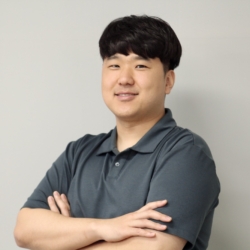김대원 Dae-Won Kim

Postdoctoral Research Fellow
Email: daewon@pusan.ac.kr
Phone: +82-51-510-7641
Research interests
- Southern Ocean circulation response to greenhouse warming
- Salinity variation
- Satellite data application
Education
| 2022 | Ph.D. Oceanography, Pusan National University, Rep. of Korea |
| 2016 | M.S. Oceanography, Pusan National University, Rep. of Korea |
| 2014 | B.S. Oceanography, Pusan National University, Rep. of Korea |
Fellowships, Awards, and Honors
| 2018 | 14th PORSEC student poster award for best presentation |
| 2018 | OASIS Student presentation awards for best presentation |
Publications
- Jisun Shin, Dae-Won Kim, So-Hyun Kim, Gi Seo Lee, Boo-Keun Khim, Young-Heon Jo, 2024. Gap-filling techniques applied to the GOCI-derived daily sea surface salinity product for the Changjiang diluted water front in the East China Sea, Earth System Science Data, vol. 16, 7, pp. 3193 – 3211, doi: 10.5194/essd-16-3193-2024
- So-Hyun Kim, Dae-Won Kim, Young-Heon Jo, 2023. GOCI-II Based Low Sea Surface Salinity and Hourly Variation by Typhoon Hinnamnor, Korean Journal of Remote Sensing, vol. 39, 6-2, pp. 1605-1613, doi: 10.7780/kjrs.2023.39.6.2.8
- So-Hyun Kim, Jisun Shin, Dae-Won Kim, Young-Heon Jo, 2023. Estimation of subsurface salinity and analysis of Changjiang diluted water volume in the East China Sea, Frontiers in Marine Science, vol. 10, Article 1247462, doi: 10.3389/fmars.2023.1247462
- Myeong-Hyeon Kim, Dae-Won Kim, Deoksu Kim, Feili Li, Young-Heon Jo, 2023. Estimation of deep-water formation intensity using multi-satellite measurements in the East Sea (Japan Sea), Deep-Sea Research Part 1: Oceanographic Research Papers, vol. 194, article 103969, doi: 10.1016/j.dsr.2023.103969
- Dae-Won Kim, So-Hyuen Kim, Ji-Yeon Baek, Jong-Seok Lee, Young-Heon Jo, 2022. GOCI-II based sea surface salinity estimation using machine learning for the first-year summer, International Journal of Remote Sensing, vol. 43(18), 6605-6623
- Kim, D. W., Kim, S. H., and Jo, Y. H., 2022 Machine Learning to Identify Three Types of Oceanic Fronts Associated with the Changjiang Diluted Water in the East China Sea between 1997 and 2021. Remote Sensing, 14(15), 3574
- Baek, J. Y., Park, J. Kim, D. W., Lee, J. S., Lee, J. Y. Lee, S. J., and Jo, Y. H., 2022. Role of aerosols in spring blooms in the Central Yellow Sea during the COVID-19 lockdown period. Frontiers in Marine Science, 1174
- Kim, D. W., Kim, S. H., and Jo, Y. H., 2021. A development for sea surface salinity algorithm using GOCI in the East China Sea. Korean Journal of Remote Sensing, 37(5-2), 1307-1315
- Kim, D. W., Park, Y. J., Jeong, J. Y., and Jo, Y. H. (2020). Estimation of Hourly Sea Surface Salinity in the East China Sea Using Geostationary Ocean Color Imager Measurements. Remote Sensing, 12(5), 755.
- Baek, J. Y., Jo, Y. H., Kim, W., Lee, J. S., Jung, D., Kim, D. W., and Nam, J. (2019). A New Algorithm to Estimate Chlorophyll-A Concentrations in Turbid Yellow Sea Water Using a Multispectral Sensor in a Low-Altitude Remote Sensing System. Remote Sensing, 11(19), 2257.
- Jeong, Y., Kim, D., Jo, Y. H., & Kim, D. W. (2019). Interactions of eddies with the Kuroshio Current based on satellite altimeter measurements. Journal of Coastal Research, 90(SI), 289-293.
- Oh, Y., Kim, D. W., Jo, Y. H., Hwang, J. D., and Chung, C. Y. (2020). Spatial variability of fishing grounds in response to oceanic front changes detected by multiple satellite measurements in the East (Japan) sea. International Journal of Remote Sensing, 41(15), 5884-5904.
- Park, J., Kim, D. W., Jo, Y. H., and Kim, D. (2018). Accuracy evaluation of daily-gridded ASCAT satellite data around the Korean Peninsula. Korean Journal of Remote Sensing, 34(2_1), 213-225.
- Choi, J. G., Jo, Y. H., Moon, I. J., Park, J., Kim, D. W., and Lippmann, T. C. (2018). Physical forces determine the annual bloom intensity of the giant jellyfish Nemopilema nomurai off the coast of Korea. Regional Studies in Marine Science, 24, 55-65.
- Jo, Y. H., Kim, D. W., and Kim, H. (2018). Chlorophyll concentration derived from microwave remote sensing measurements using artificial neural network algorithm. J. Mar. Sci, 26, 102-110.
- Kim, D. W., Jo, Y. H., Choi, J. K., Choi, J. G., and Bi, H. (2016). Physical processes leading to the development of an anomalously large Cochlodinium polykrikoides bloom in the East sea/Japan sea. Harmful Algae, 55, 250-258.